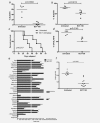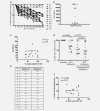The arginine metabolome in acute lymphoblastic leukemia can be targeted by the pegylated-recombinant arginase I BCT-100
- PMID: 29168171
- PMCID: PMC5849425
- DOI: 10.1002/ijc.31170
The arginine metabolome in acute lymphoblastic leukemia can be targeted by the pegylated-recombinant arginase I BCT-100
Abstract
Arginine is a semi-essential amino acid that plays a key role in cell survival and proliferation in normal and malignant cells. BCT-100, a pegylated (PEG) recombinant human arginase, can deplete arginine and starve malignant cells of the amino acid. Acute lymphoblastic leukemia (ALL) is the most common cancer of childhood, yet for patients with high risk or relapsed disease prognosis remains poor. We show that BCT-100 is cytotoxic to ALL blasts from patients in vitro by necrosis, and is synergistic in combination with dexamethasone. Against ALL xenografts, BCT-100 leads to a reduction in ALL engraftment and a prolongation of survival. ALL blasts express the arginine transporter CAT-1, yet the majority of blasts are arginine auxotrophic due to deficiency in either argininosuccinate synthase (ASS) or ornithine transcarbamylase (OTC). Although endogenous upregulation or retroviral transduced increases in ASS or OTC may promote ALL survival under moderately low arginine conditions, expression of these enzymes cannot prevent BCT-100 cytotoxicity at arginine depleting doses. RNA-sequencing of ALL blasts and supporting stromal cells treated with BCT-100 identifies a number of candidate pathways which are altered in the presence of arginine depletion. Therefore, BCT-100 provides a new clinically relevant therapeutic approach to target arginine metabolism in ALL.
Keywords: ALL; arginase; arginine.
© 2017 The Authors International Journal of Cancer published by John Wiley & Sons Ltd on behalf of UICC.
Figures





Similar articles
-
Recombinant human arginase induces apoptosis through oxidative stress and cell cycle arrest in small cell lung cancer.Cancer Sci. 2018 Nov;109(11):3471-3482. doi: 10.1111/cas.13782. Epub 2018 Oct 6. Cancer Sci. 2018. PMID: 30155941 Free PMC article.
-
Pegylated recombinant human arginase (rhArg-peg5,000mw) inhibits the in vitro and in vivo proliferation of human hepatocellular carcinoma through arginine depletion.Cancer Res. 2007 Jan 1;67(1):309-17. doi: 10.1158/0008-5472.CAN-06-1945. Cancer Res. 2007. PMID: 17210712
-
Arginine dependence of acute myeloid leukemia blast proliferation: a novel therapeutic target.Blood. 2015 Apr 9;125(15):2386-96. doi: 10.1182/blood-2014-09-600643. Epub 2015 Feb 20. Blood. 2015. PMID: 25710880 Free PMC article.
-
Molecular basis and current strategies of therapeutic arginine depletion for cancer.Int J Cancer. 2016 Aug 1;139(3):501-9. doi: 10.1002/ijc.30051. Epub 2016 Apr 15. Int J Cancer. 2016. PMID: 26913960 Review.
-
Anti-tumor efficacy of a recombinant human arginase in human hepatocellular carcinoma.Curr Cancer Drug Targets. 2012 Nov 1;12(9):1233-43. doi: 10.2174/156800912803988002. Curr Cancer Drug Targets. 2012. PMID: 22873218 Review.
Cited by
-
Collaboration Between RSK-EphA2 and Gas6-Axl RTK Signaling in Arginine Starvation Response That Confers Resistance to EGFR Inhibitors.Transl Oncol. 2020 Feb;13(2):355-364. doi: 10.1016/j.tranon.2019.12.003. Epub 2019 Dec 27. Transl Oncol. 2020. PMID: 31887630 Free PMC article.
-
Dual targeting of polyamine synthesis and uptake in diffuse intrinsic pontine gliomas.Nat Commun. 2021 Feb 12;12(1):971. doi: 10.1038/s41467-021-20896-z. Nat Commun. 2021. PMID: 33579942 Free PMC article.
-
Next generation oncolytic viruses expressing PADI1 and TIMP2 exhibit anti-tumor activity against melanoma in nude and humanized mouse models.Mol Ther Oncolytics. 2023 Jan 13;28:158-170. doi: 10.1016/j.omto.2023.01.002. eCollection 2023 Mar 16. Mol Ther Oncolytics. 2023. PMID: 36816748 Free PMC article.
-
Amino acids in hematologic malignancies: Current status and future perspective.Front Nutr. 2023 Mar 23;10:1113228. doi: 10.3389/fnut.2023.1113228. eCollection 2023. Front Nutr. 2023. PMID: 37032776 Free PMC article. Review.
-
Cationic Amino Acid Transporter-1-Mediated Arginine Uptake Is Essential for Chronic Lymphocytic Leukemia Cell Proliferation and Viability.Front Oncol. 2019 Nov 20;9:1268. doi: 10.3389/fonc.2019.01268. eCollection 2019. Front Oncol. 2019. PMID: 31824848 Free PMC article.
References
-
- Bautista F, Van Der Lugt J, Kearns PR, et al. The development of targeted new agents to improve the outcome of children with leukemia. Expert Opin Drug Discov 2016;11:1111–22. - PubMed
-
- Goldstone AH, Richards SM, Lazarus HM, et al. In adults with standard‐risk acute lymphoblastic leukemia, the greatest benefit is achieved from a matched sibling allogeneic transplantation in first complete remission, and an autologous transplantation is less effective than conventional consolidation/maintenance chemotherapy in all patients: final results of the International ALL Trial (MRC UKALL XII/ECOG E2993). Blood 2008;111:1827–33. - PubMed
-
- Evans RW, Fernstrom JD, Thompson J, et al. Biochemical responses of healthy subjects during dietary supplementation with L‐arginine. J Nutr Biochem 2004;15:534–9. - PubMed
Publication types
MeSH terms
Substances
Grants and funding
LinkOut - more resources
Full Text Sources
Other Literature Sources
Research Materials
Miscellaneous

